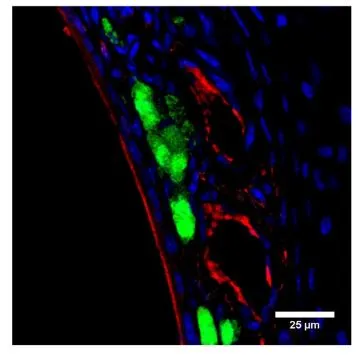
IHC analysis of mouse nose tissue using GTX14784 PGCB antibody. Staining is found on blood vessel walls. Red : Primary antibody Green : Greneberg ganglion nerons Staining is found on blood vessel walls.
PGCB antibody
GTX14784
ApplicationsImmunoFluorescence, ImmunoPrecipitation, Western Blot, ELISA, ImmunoCytoChemistry, ImmunoHistoChemistry
Product group Antibodies
ReactivityHuman, Mouse, Rat
TargetNPR2
Overview
- SupplierGeneTex
- Product NamePGCB antibody
- Delivery Days Customer9
- Application Supplier NoteWB: 1:500. ICC/IF: 1:200. IP: 1:200. ELISA: 1:10000. IHC: 1:200. *Optimal dilutions/concentrations should be determined by the researcher.Not tested in other applications.
- ApplicationsImmunoFluorescence, ImmunoPrecipitation, Western Blot, ELISA, ImmunoCytoChemistry, ImmunoHistoChemistry
- CertificationResearch Use Only
- ClonalityPolyclonal
- Concentration0.75-1.20 mg/ml
- ConjugateUnconjugated
- Gene ID4882
- Target nameNPR2
- Target descriptionnatriuretic peptide receptor 2
- Target synonymsAMDM; ANPb; ANPRB; atrial natriuretic peptide B-type receptor; atrial natriuretic peptide receptor 2; atrial natriuretic peptide receptor type B; ECDM; GCB; GC-B; guanylate cyclase 2B; guanylate cyclase B; guanylyl cyclase B; GUC2B; GUCY2B; natriuretic peptide receptor B/guanylate cyclase B (atrionatriuretic peptide receptor B); NPRB; NPRBi; SNSK
- HostRabbit
- IsotypeIgG
- Protein IDP20594
- Protein NameAtrial natriuretic peptide receptor 2
- Scientific DescriptionThis gene encodes natriuretic peptide receptor B, one of two integral membrane receptors for natriuretic peptides. Both NPR1 and NPR2 contain five functional domains: an extracellular ligand-binding domain, a single membrane-spanning region, and intracellularly a protein kinase homology domain, a helical hinge region involved in oligomerization, and a carboxyl-terminal guanylyl cyclase catalytic domain. The protein is the primary receptor for C-type natriuretic peptide (CNP), which upon ligand binding exhibits greatly increased guanylyl cyclase activity. Mutations in this gene are the cause of acromesomelic dysplasia Maroteaux type. [provided by RefSeq, Jul 2008]
- ReactivityHuman, Mouse, Rat
- Storage Instruction-20°C or -80°C,2°C to 8°C
- UNSPSC12352203

